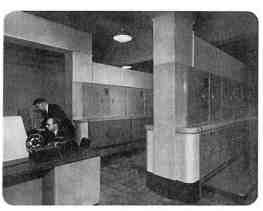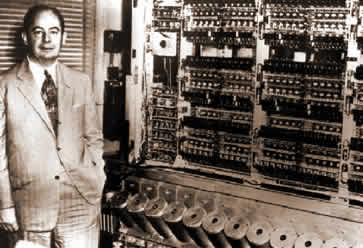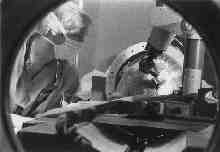|
|
|
Contents |
With the explosive development of the computer in the second half of the 20th Century there was a whole new set of concepts to use in thinking about the brain and the mind, a set of concepts which were at already bringing enormous success and excitement in one area of human enterprise, automatic calculation and data-manipulation. I mean concepts of software and hardware, algorithm, routine and subroutine, program, machine language and so on. These concepts were extremely suggestive when applied in the attempt to get some understanding of the brain and the mind.
 |
| The Manchester Universal Electronic Computer, pic courtesy Alan Turing. net |
So the notion was that the brain might be one of these new computers, or at least it might be one of these new computers developed to the nth degree. The new computers filled large rooms of course, and brains only filled sometimes quite small skulls, but the principle was the thing.
What is it about a computer that make the claim that that's what a brain is interesting?
Brains have been likened to physical devices before - to telephone exchanges in the early 20th Century, to wheat-grinding mills in the 17th Century. But the computer seems to be a more powerful machine than either of these two, or than any other artificial device whatever.
The new model quickly made the Identity Theory seem antiquated. For a short period (Place's paper was published in 1956) , Identity Theory was the Flag Carrier of phyicalism. But the new concepts developed in connection with the computer soon provided more elaborate ways of developing the physicalist vision.
The great new concept from the point of view of thinking about the relation between brain and mind was software. Software ran on hardware. But both seemed to be physical enough. What happens when you equip a computer with software is that you adjust its physical state. That's what software is: an aspect of the physical state of the machine. But there is in spite of this a sustainable distinction between machine and software running on it, a distinction computer people understood perfectly clearly. Those that understood it suggested that software could be thought of as throwing light on conscious experience…. If conscious experience could be paralleled with software we could think of consciousness as physical, like software, but not crudely so.
We need to remind ourselves exactly what software is.
It's a set of instructions.
It tells the machine exactly what it has to do.
In the old days a compter's instructions were coded in a series of cards with holes punched in them. You punched the holes in different patterns depending on what you wanted the machine to do.
Before you give it the cards, it can do very little. It has a repertoire of basic operations, and the cards tell it which ones to carry out.
The operations of the basic repertoire really are very simple.
| Early mechanical calculator by Pascal. Pic courtesy James Redin |
For example, the machine can add.
Let's think of the basic features of the type of computer in almost universal use today: the von Neumann computer, named after the mathematician von Neumann who played a ket part in the development of the electronic computer in the middle of the twentieth century.
The von Neumann computer has a central processor, and then a vast bank of pigeonholes for numbers.
Basically what the processor does is to get a number from aspecified pigeonhole, do something with it, and put the result back in the same or another pigeonhole.
That's basically it.
What are the operations it can do? It varies from processor to processor, but essentially they are simple arithmetic operations. For example, addition. It can add. It does this by getting a number from one location in store, putting it in a special pigeonhole called a register (say A); getting another number from a specified pigeonhole and putting it in a second register (B) and adding the two together, then putting the result in an output register.
Yes but how does it do the actual adding?
It just follows some elementary rules.
We had better do it.
| How to be an adder |
So the central processor of the von Neumann machine can add. It can also subtract, doing the same things except applying different rules. And you will know that if it can add, it will be able to multply, since multiplying is just repeated adding. And a machine that can add and subtract can also divide, by combining these two operations in the appropriate way.
 |
| John von Neumann with the pioneering ENIAC machine. Pic coutesy Institut für Mathematik und ihre Didaktik |
The magnificent power of the computer is achieved by getting it to perform sequences of these elementary operations - sequences that of course become extremely extended.
So 'software' is the sequence of instructions that a computer works to. It is itself a sequence of numbers. Such and such a number is the code for 'add', such and such a number is the code for 'increment the counter', and each number store - each pigeonhole - is addressed by a number. This means that the list of instructions can itself be stored in the machine. So in one part of the memory of the machine sits a sequence of numbers - the sequence fo numbers which is the sequence of instructions the machine is to follow.
Hardware is the machine: a central processor with a repertoire of elementary operations such as fetching a number, or adding one to the number in register A.
How does this help with a physicalist understanding of the brain?
 |
| The sea urchin: good at surviving. Pic courtesy Reuben Clements |
We are to suppose that the brain is a computer, working through a sequence of instructions, the programme.
The programme is developed for the animal by natural selection. The instructions are broadly designed (by natural selection) to keep the animal alive, and to keep reproducing. It receives data from the environment, works out its significance for survival and passes on instructions to the body accordingly.
For example, the programme might instruct the computer to tell the body to run off if a big image of a mad bull appears on the retina.
In general, the system has input. The input is then manipulated in some way by the computer, which results in stimulation of some kind being passed to the muscles of the body.
The brain is thought of as having a programme then - a piece of software - that takes in input, manipulates it, and generates output. The programme that thus links input and output is sometimes called in the literature the 'global psychology' of the animal concerned.
If you adopt this picture of the brain and its programme, there are three kinds of description you can develop - and here we come to the crunch.
 |
| Robots assist in brain probes. . Pic courtesy NASA |
The first is the type of description that the neorophysiologist would aim for. S/he would look at the brain and describe the pattern of neurophysiological activity. 'This network of neurons is active when adrelin secretion reach such and such a level, and when it has been active for more than 5 milliseconds, such and such another cluster of neurons is activated' - and so on.
There is another type of description we can develop however, if we are trying to think of the brain as a computer running a programme. We can say what the proigramme is up to at any one point. We might say: The brain is now calculating how near the bull is.
If this calculation is indeed being done, it will be being done through neorphysiological activity of some sort.
One thing is going on, but we can describe it in two ways. We can describe the neurphysiological activity, and we can describe the calculating function that that activity is carrying out.
Only one thing is happening, but two descriptions, two 'levels' of description.
Think of the parallel with a desk-top computer.
You type in 'add four and 69'. It goes ahead and conducts this calculation. What is going on in the machine? Electronic switches are going on and off in accordance with the instructions represented in the machine. But also: the machine is adding two numbers.
Two descriptions, one reality.
Web stuff |
|
So with computers, and with the brain if it is a computer, we can speak of two levels of description. Is there perhaps a third?
Physicalists suggest that there is. They say there is a mental level of description too.
To understand what they are proposing here we must go back to the Identity Theory and a difficulty with it.
The Identity Theory mainatined that a mental event, for example a pain, was to be thought of as identical with a physical process going on the the brain.
One difficulty raised against it was that this would mean that an animal with a different nervous system would not be able to suffer pain.
Machine Functionalism suggests a solution to this difficulty: perhaps the pain is not to be identified with a neurophysiological process, but with the function, within the global programme of the creature, that a particular neurophysiological process is carrying out.
To explain this I need to bring to the front the idea that one and the same programme can run on different hardware platforms.
END